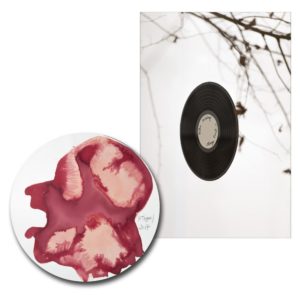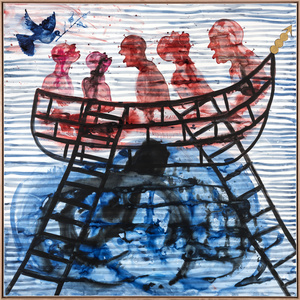
Bathélémy Toguo
Strange Fruit, 2017.
About:
Barthélémy Toguo, born in 1967 in Cameroon, lives and works today in Paris and Bandjoun, Cameroon. He began his studies at the Abidjan School of Fine Arts, Côte d’Ivoire. His artistic apprenticeship at first involved his fashioning copies of classic European sculptures, until he took part in a workshop in 1992 devoted to woodcarving, an event that enabled him to radically modify his approach. He decided then to continue his studies in France in order to experience a different type of instruction and enjoy greater liberty in his personal creative research. He took classes at Grenoble’s Graduate School of Art and later enrolled in Klaus Rinke’s studio at the Kunstakademie in Düsseldorf.

Strange Fruit, 2017.
It was in Grenoble that Toguo discovered photography and video, before his encounter with “German realism” in Düsseldorf. He also became interested in performance art at this time. In 1996, for example, he undertook the series he called Transit. These performances always took place in airports, train stations and other places of transit. For a flight at Roissy-Charles De Gaulle airport, for instance, the artist arrived for boarding wearing a cartridge belt… filled with caramel candies. Or, picking up his bags upon arriving from Africa, he was stopped by customs because his suitcases were carved from solid wood. Another time, dressed as a street sweeper, he seated himself in the first-class compartment of the Thalys Cologne-Paris train. His peculiar dress made other travelers ill at ease and led the conductor to threaten to have him put off the train.

Déluge I, 2016.
Humor and a certain form of provocation thus made their way into Toguo’s art. This provocation can be seen in his performance Pure & Clean, which he created at White Box (New York) in February 2001. In this piece, the artist washed two American flags by hand before hanging them out to dry on a line. His act is rooted in the place the United States occupies on the international scene, which the artist deems arrogant, i.e., the death penalty, the refusal to ratify the Kyoto Protocol on reducing hothouse gas emissions, and so on.
The artist began to work with watercolor in 1998; born of his many trips and experiences, this practice yields a kind of logbook or travel diary. Toguo has done several such watercolor series. There is Baptism, a celebration of the human body, which was shown for the first time in 1999 at the Kunstmuseum in Düsseldorf, or more recently Dream Catchers (2002-2003). He has also executed series of drawings like Festival of Grapes, Das Bett (1995) a piece inspired by the artist’s daily life featuring various objects and living beings.
In 1997, the municipality of Grenoble offered him the wood from a number of sick acacia trees that had to be cut down. Toguo decided to spend two weeks next to these plants to learn what they themselves “saw” and so made the acquaintance of the cross-dressers who took over the park after dark. From the wood of these trees he eventually carved high-heel shoes in reference to the transvestites’ getup, calling the pieces Folies nocturnes.
Toguo’s work harbors a political dimension as well. He is interested in flows, be it of merchandise or human beings, and those who regulate them. His series of wood sculptures of giant rubber stamps (The New World Climax) that sport inscriptions like “carte de séjour” (resident permit) and “the world of citizens” refers to the individuals who apply, or do not apply, that salutary stamp to one’s passport. With his installation Mamadou Airlines, the artist presents a cluttered runway on which the airplanes are stuck. The idea here is to show that the West gladly takes in natural resources from the Third World but far fewer numbers of people from there.

Forever Growing, 2016.
Toguo is likewise concerned by art’s presence in Africa and especially Cameroon. Indeed, his native country possessed neither museum nor art school before the artist himself decided to found in 1999 the Institute of Visual Arts in Bandjoun. Devoted to the full range of art disciplines, the institute, which is currently under construction, will make it possible to host exhibitions, informal gatherings, workshops and even residencies for artists.
Recently, the artist has turned his attention to the realm of the stage and the theatrical arrangement of space. At the Lyon biennial in 2000, for example, he showed Unfinished Theater, which combined wood sculpture, inscriptions, photographs and video. This installation seemed like a kind of mise en scène of his experiences and recent travels. In 2004 at the Palais de Tokyo, a site for the contemporary arts, he put together several theatrical settings under the general title of The Sick Opera. For Toguo, we are all actors, each of us playing a pre-established role in society. His installations are but a reflection of life while his work is life. (text on website artist)
Daria Joubert
